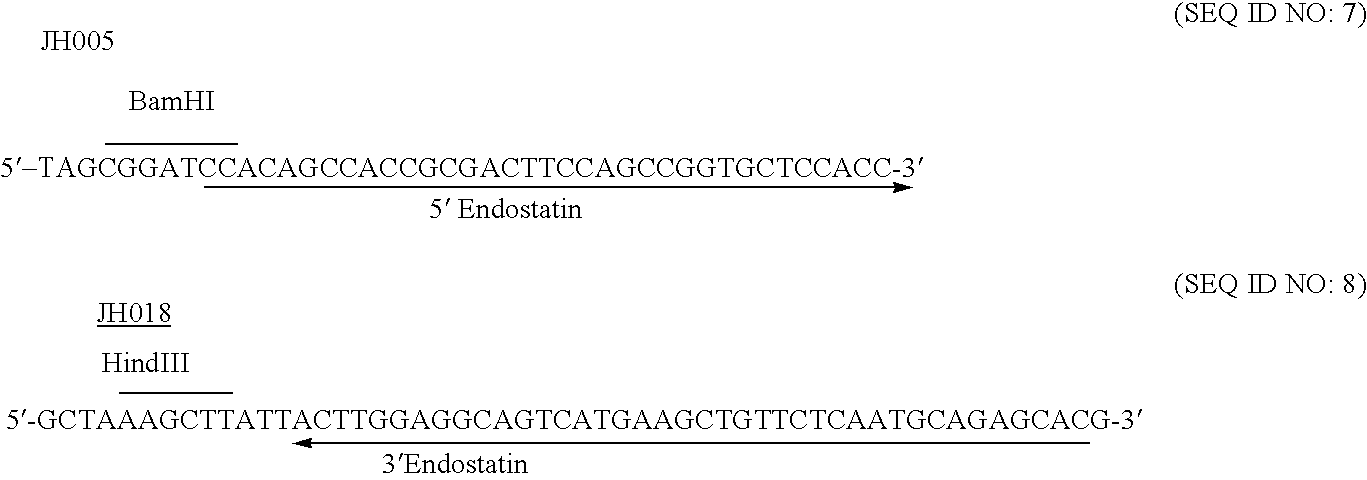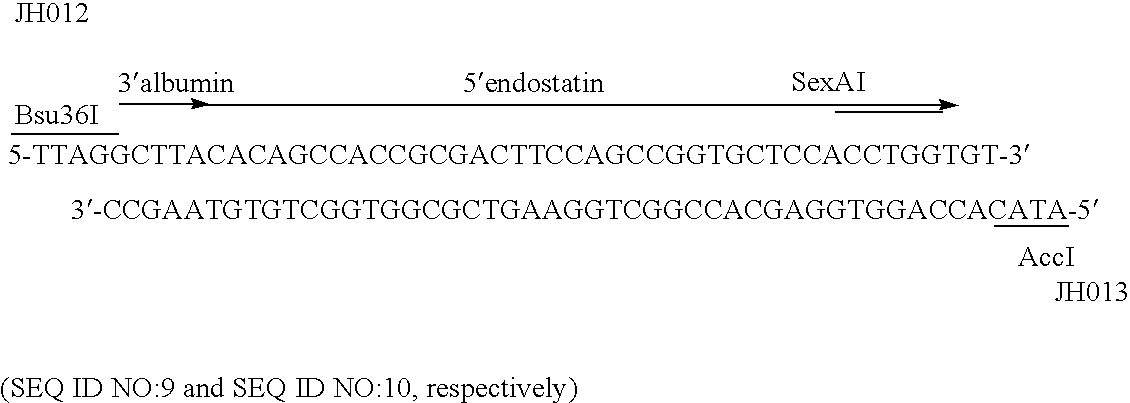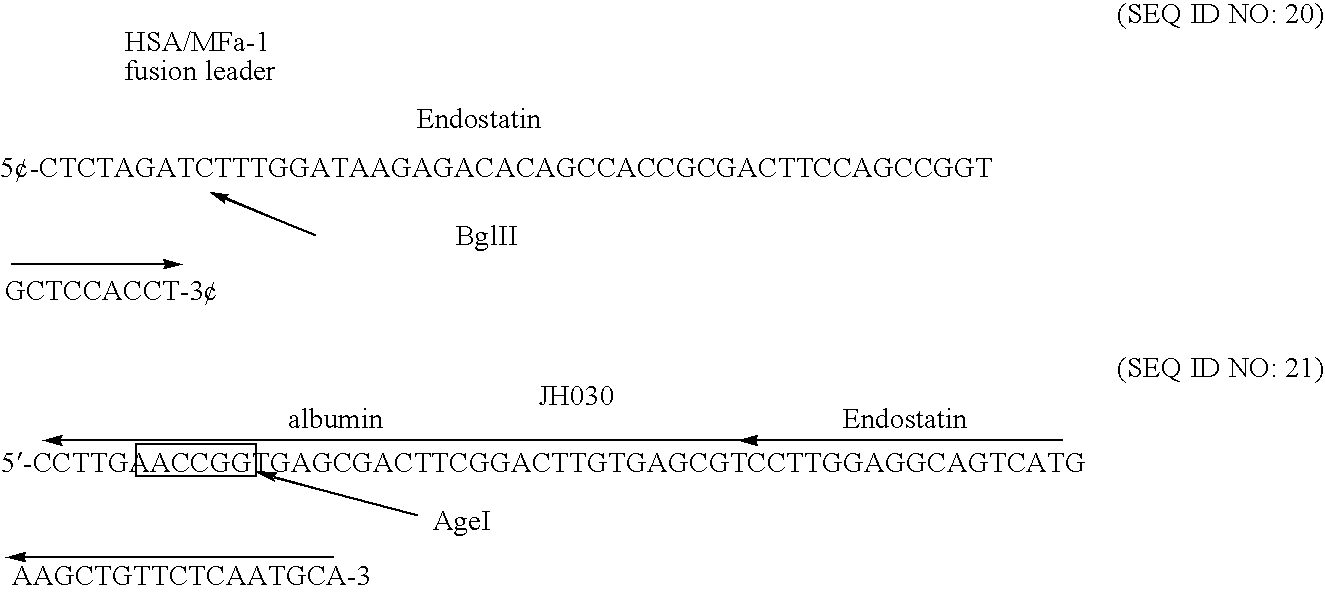Albumin-fused anti-angiogenesis peptides
an anti-angiogenesis and albumin technology, applied in the field of anti-angiogenesis peptides and albumin fusion proteins, can solve the problems of standard chemotherapy, cancer cells are inherently genetically unstable, agents that are effective against one particular type of cancer fail to fight a different type of cancer, etc., and achieve the effect of improving the scheduling of the dosing of an anti-angiogenesis peptid
- Summary
- Abstract
- Description
- Claims
- Application Information
AI Technical Summary
Benefits of technology
Problems solved by technology
Method used
Image
Examples
example 1
Cloning of a Human Endostatin cDNA
[0326] DNA from a human foetal kidney 5′-STRETCH Plus cDNA Library (Clonetech) was extracted by phenol / chloroform extraction, ethanol precipitated and then digested with RNaseA to remove any RNA present in the DNA sample. The DNA was serially diluted from 100 ng to 10 pg (in 10 fold increments). PCR primers JH005 and JH018 were designed to clone a BamHI site into the 5′ end of endostatin, and a HindIII site into the 3′ end of endostatin. The DNA sequence of each primer were as follows:
[0327] A master mix was prepared as follows: 2 mM MgCl2 PCR Buffer, 10 μM PCR dNTP's, 0.2 μM JH005, 0.2 μM JH018, 2U FastStart Taq. DNA polymerase. 1 μL of template DNA (10 pg, 100 pg, 1 ng, 10 ng, 100 ng) was added to 49 μL of reaction mix. The total reaction volume was 50 μL. Perkin-Elmer Thermal Cycler 9600 was programmed as follows: denature at 95° C. for 4 mins [HOLD], then [CYLCE] denature at 95° C. for 30 s, anneal for 30 s at 45° C., extend at 72° C. for 60 ...
example 2
Construction of C-Terminal and N-Terminal Albumin-Endostatin Expression Plasmids
Construction of C-Terminal Albumin-Endostatin Expression Plasmid
[0329] A C-terminal rHA-endostatin fusion were constructed wherein the C-terminal amino acid of albumin was followed by the first N-terminal amino acid of human endostatin.
[0330] A double stranded oligonucleotide linker was designed to manufacture the junction site between albumin and endostatin coding regions. The oligonucleotide pair JH012 / JH013 was designed to extend from the Bsu36I site within albumin cDNA to the SexAI site within the 5′ region of endostatin cDNA. An AccI site was engineered into the 3′ end of the linker to allow the linker to be cloned into pDB2243, previously described in patent application WO 00 / 44772. Plasmid pDB2243, which contained the yeast PRB1 promoter and the yeast ADH1 terminator, provided appropriate transcription promoter and transcription terminator sequences.
[0331] The oligonucleotide linker JH012 / JH...
example 3
Cloning of a Human Angiostatin cDNA
[0341] A human liver 5′-STRETCH plus cDNA library (Clonetech) was selected as a source of a human angiostatin cDNA as the liver is the main producer of plasminogen. The DNA was extracted by phenol / chloroform extraction, ethanol precipitated and then digested with RNaseA to remove any RNA present in the DNA sample. The DNA was serially diluted from 100 ng to 10 pg (in 10 fold increments). Two mutagenic PCR primers JH003 and JH004 were designed to introduce a BamHI site into the 5′ end of angiostatin (JH004), and a HindIII site into the 3′ end of angiostatin (JH003).
[0342] The angiostatin cDNA was amplified by PCR using the primers JH003 and JH004. A master mix was prepared as follows: 2 mM MgCl2 PCR Buffer, 10 μM PCR dNTP's, 0.2 μM JH003, 0.2 μM JH004, 2U FastStart Taq. DNA polymerase (Roche). 1 μL of DNA (10 pg, 100 pg, 1 ng, 10 ng, 10 ng) was added to 49 μL of reaction mix. The total reaction volume was 50 μL. Perkin-Elmer Thermal Cycler 9600 w...
PUM
| Property | Measurement | Unit |
|---|---|---|
| molecular weight | aaaaa | aaaaa |
| molecular weight | aaaaa | aaaaa |
| volume | aaaaa | aaaaa |
Abstract
Description
Claims
Application Information
 Login to View More
Login to View More - R&D
- Intellectual Property
- Life Sciences
- Materials
- Tech Scout
- Unparalleled Data Quality
- Higher Quality Content
- 60% Fewer Hallucinations
Browse by: Latest US Patents, China's latest patents, Technical Efficacy Thesaurus, Application Domain, Technology Topic, Popular Technical Reports.
© 2025 PatSnap. All rights reserved.Legal|Privacy policy|Modern Slavery Act Transparency Statement|Sitemap|About US| Contact US: help@patsnap.com



